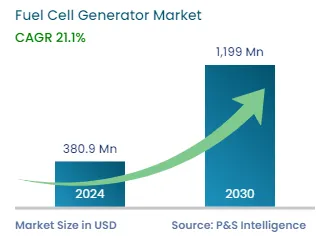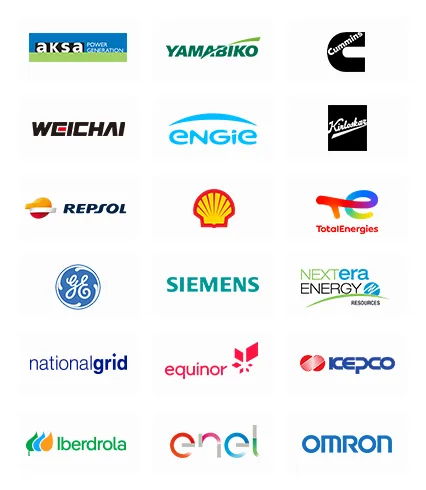Market Statistics
| Study Period | 2019 - 2030 |
| 2024 Market Size | USD 380.9 Million |
| 2030 Forecast | USD 1199 Million |
| Growth Rate (CAGR) | 21.1% |
| Largest Region | North America |
| Fastest Growing Region | Asia-Pacific |
| Nature of the Market | Fragmented |
Report Code: 12506
Get a Comprehensive Overview of the Fuel Cell Generator Market Report Prepared by P&S Intelligence, Segmented by Type (Hydrogen Fuel Cell Generators, Methanol Fuel Cell Generators), End User (Marine, Construction, Mining, Agriculture, Aquaculture, Data Centers, Emergency Response Generators), and Geographic Regions. This Report Provides Insights From 2019 to 2030.
| Study Period | 2019 - 2030 |
| 2024 Market Size | USD 380.9 Million |
| 2030 Forecast | USD 1199 Million |
| Growth Rate (CAGR) | 21.1% |
| Largest Region | North America |
| Fastest Growing Region | Asia-Pacific |
| Nature of the Market | Fragmented |

Explore the market potential with our data-driven report
The fuel cell generator market size stood at USD 380.9 million in 2024, and it is expected to advance at a compound annual growth rate of 21.1% during 2024–2030, to reach USD 1,199 million by 2030.
The growth of the industry can be primarily ascribed to the various factors, such as renewability of energy, easy accessibility of fuel cell generators, minimalization of carbon residues. The increasing demand for generation of clean power along with minimal emissions from carbon.
Other driving factors include the stimulus packages and financial advantages to support the green innovation infrastructure, rising fossil fuel byproducts from power stations and enterprises, and low expansion of responsibility for generators. Advantages of the innovation in the power devices incorporate low-to-zero discharges, higher proficiency, dependability, source adaptability, energy security, durability, versatility, and are free from any.
Investments to Achieve Zero Carbon Emissions Propels Demand
Hydrogen fuel cell generator holds the largest share of around 55%, as they do not produce harmful emissions which in turn eliminates the cost related to handling and storage of toxic materials. This type of generator is reliable, provides approximately 40-60% energy efficiency, and scalability.
Several regions and countries around the world have made their intentions clear to reduce overall emissions of greenhouse gases to zero by 2050, that means achieving carbon neutrality. The government initiatives has increased for creating a decarbonized society in the past few years. In order to achieve this target, the introduction of renewable sources, such as wind, solar, hydro, biomass, and geothermal, is important.
However, the generation of energy with the help of wind and solar has several disadvantages, such as the lack of capabilities to adjust generation and large amount of output variations depending on weather conditions in order to fulfil the demand. Thus, the electricity generation requires a system to store the surplus in batteries or via other methods, and deal with power shortage.
Moreover, it is projected that hydrogen is gaining traction as a next generation source of energy. It is present in abundance, and can be used to produce electricity and thermal energy through chemical reaction and combustion without emitting carbon-dioxide. It is quite easy to store and use hydrogen because it can be stored stably for a long time and electricity from renewable energy can be generated from hydrogen through electrolysis. These are the various factors which are expected to boost the demand for fuel cell generator.
Methanol fuel cell generator is expected to show a significant growth in the forecast period and is attributed to its smaller size, easy refueling and lightweight. Moreover, the system is autonomous, which means it can start and stop according to the necessities. Systems that run on methanol have various benefits, such as it can be fitted to the application or as a stand-alone enclosure with or without a built-in tank. It can supply around 100 kWh power per day and can be charged with an on-shore power connection (standard), wind turbines, water turbines or other external 48 V DC/230 V AC sources. With wind or water energy, it develops into the Green Off grid solution that also can supply heat and hot water if needed. Furthermore, It is scalable and whenever there is a need for lots of energy in short bursts or for a long time.

Aquaculture is fastest growing end user at a CAGR of around 19.2%, attributed to the growing number of aquaculture facilities and rising environmental impacts associated with it including consumption of water and electricity. In order to minimize the environmental impacts, governments have taken several actions for using fuel cell-based generators instead of diesel generators.
According to the estimates of the National Oceanic and Atmospheric Administration, aquaculture in the U.S. represents a USD 1.5 billion value annually which helps and supports 1.7 million jobs in the seafood industry.
Data centers include installation of backup power solutions. The increasing requirement for backup electricity during power outage is further expected to drive the demand. The data centers require to process large amounts, which is way more important as technology and continues to grow in the daily lives in a digitized environment. The development of Internet of Things (IoT) will continue to develop, and improve almost every aspect people’s lives. The technology can be utilized to improve manufacturing operations and equipment monitoring.
With the expansion of digital world, the demand for reliable data centers is increasing. It is projected that California is struggling to meet consumers electricity needs. Grid limitations drive companies to invest in backup generators. Various data centers have started installing fuel cell generators in order to support the technological progressions. Since the outbreak of the pandemic, the staff were less which drives the acceptance of self-directed devices. Currently, different distribution centers are utilizing novel innovations to increase productivity and reduce emissions.
The utilization of AI enabled surveillance, AR, and mechanical technology, for cutting-edge staff work. When driven by hydrogen, the innovation reduces errors and further increases speed, moderating output, and other important resources. Over a long time, the systems can essentially diminish ozone-harming substance discharges and improve data storage, and computing capacities. Data centers can decrease carbon emissions by enhancing their alternative resources. They have the potential to support the economy and electric grid by using abundant hydrogen energy. Moreover, they can coordinate their sources of power with supportable devices.
Numerous centers are decreasing the environmental impacts by the use of low-emission technologies. For ideal sustainability practices, they run their thermostats, lights, and smart appliances on green hydrogen. Over time, the usage of ecological technologies will decrease the emissions and will lead to the conservation of the environment.
Drive strategic growth with comprehensive market analysis
North America has the leading position in the fuel cell generator market, and it will hold the same position till 2030, with a value of USD 360 million. This is attributed to the increasing focus and rapid adoption of clean sources.
In North America, the U.S. holds the leading position, and it will grow with a CAGR of 18.1%, attributed to the strong financial support.
The innovative developments in the use of renewable resources and increasing electricity demand from data centers and aquaculture sector are some of the factors driving the growth of the market in the coming years. The increasing investments and government initiatives in the renewable sector is projected to propel the demand.
These systems offer a highly efficient and energy-source-flexible technology that produces clean power and heat with low or zero emissions.
In the U.S. October is a National Clean Energy Action month for creating awareness in order to increase the adoption of clean sources. The FEMP helps agencies meet federal energy efficiency and renewable laws and requirements. Agencies are making tremendous progress by implementing the regulations of energy- and water-management projects throughout the U.S.

Based on Type
Based on End User
Geographical Analysis
The total size of the fuel cell generator market was USD 380.9 million in 2024.
The size of the fuel cell generator industry in 2030 will be USD 1,199 million.
Fuel cell generator market will grow at a rate of 21.1% in the near future.
North America is dominating the fuel cell generator industry.
APAC is the fastest growing in the fuel cell generator market.
Want a report tailored exactly to your business need?
Request CustomizationLeading companies across industries trust us to deliver data-driven insights and innovative solutions for their most critical decisions. From data-driven strategies to actionable insights, we empower the decision-makers who shape industries and define the future. From Fortune 500 companies to innovative startups, we are proud to partner with organisations that drive progress in their industries.


Working with P&S Intelligence and their team was an absolute pleasure – their awareness of timelines and commitment to value greatly contributed to our project's success. Eagerly anticipating future collaborations.
McKinsey & Company
IndiaOur insights into the minutest levels of the markets, including the latest trends and competitive landscape, give you all the answers you need to take your business to new heights
We take a cautious approach to protecting your personal and confidential information. Trust is the strongest bond that connects us and our clients, and trust we build by complying with all international and domestic data protection and privacy laws
Customize the Report to Align with Your Business Objectives
Request the Free Sample Pages